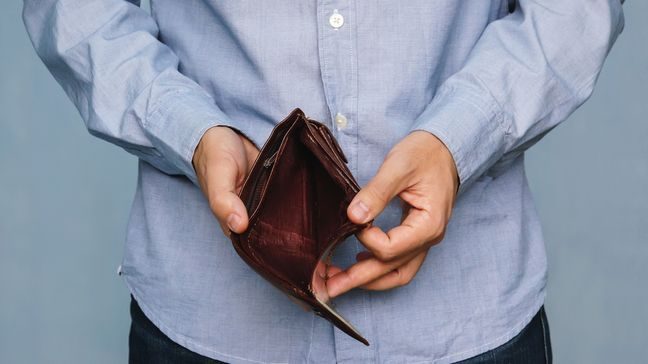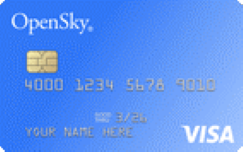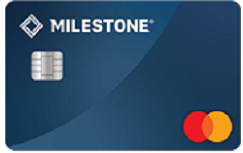Bankruptcy is tricky. It can be a positive thing that gives you a fresh start, but it comes with a number of negative side effects. One of these is that it can destroy your credit. Although rebuilding credit after filing for bankruptcy is possible, it can take years to recover and gain trust from lenders again. Typically, bankruptcies stay on your credit report for between seven and 10 years. But you don’t have to wait for them to clear to apply for credit.
If you’ve had to go through bankruptcy, opening a credit card can help you get your credit back on track by reporting positive payment history to the credit bureaus and giving you a safe way to borrow temporarily. In this article, we’ll talk about the five best secured and unsecured credit cards that accept bankruptcies and help you choose one.
What’s Ahead:
- Best credit cards after bankruptcy
- Best for no credit check: OpenSky® Secured Visa® Credit Card
- Best for no annual fee: Indigo® Mastercard® Credit Card
- Best for cash advances: Milestone Mastercard®
- Best for fair credit: Capital One QuicksilverOne Cash Rewards Credit Card
- Best for rebuilding credit: Capital One Platinum Secured Credit Card
- Secured vs. unsecured: Which is better?
- How to choose a credit card when you’re rebuilding credit
- Can you get approved for a credit card after bankruptcy?
- Summary
Best credit cards after bankruptcy
Best for no credit check: OpenSky® Secured Visa® Credit Card
Best for no annual fee: Indigo® Mastercard® Credit Card
Best for cash advances: Milestone Mastercard®
Best for no credit check: OpenSky® Secured Visa® Credit Card
Pros
- No credit check required to apply
Cons
- $35 annual fee
- 3% foreign transaction fee
- Security deposit required
If you want to avoid a credit check entirely, the OpenSky® Secured Visa® Credit Card might be the right choice for you. This is a great secured credit card that requires a refundable security deposit starting at $200 and doesn’t use a hard credit pull when you apply.
After you apply, you should receive a decision within 24 to 48 hours. Then, you get to set your credit limit yourself by depositing between $200 and $3,000. You can get your deposit back after closing your credit card and paying off your balance in full.
The $35 annual fee is lower than you’ll find at some other major credit card brands, which is helpful for keeping costs down. The interest rate is also relatively low, especially for a credit card you can get with no credit or bad credit, at 22.14% (Variable). However, be aware that this card does charge foreign transaction fees, late fees, and cash advance fees.
With a maximum credit limit of $3,000, this is an excellent choice for people looking for a higher credit line who are willing to make a hefty security deposit. This is also the best option for those who have filed for bankruptcy very recently. But if you’re hoping for a secured credit card that converts to an unsecured account, check out the Capital One Platinum Secured Mastercard.
Best for no annual fee: Indigo® Mastercard® Credit Card
Pros
- No annual fee for some applicants
- No cash advance fee for the first year
- Low foreign transaction fee of 1%
Cons
- Annual fee of up to $99 for some applicants
The Indigo® Mastercard® Credit Card is a no-frills unsecured card you can qualify for after bankruptcy, and you may be able to qualify to have the annual fee waived.
If you want to get this card, the first thing you should do is check to see if you pre-qualify. You can submit a pre-qualification application with no effect on your credit in about a minute. By doing this, you’re checking to see not only if you’re eligible to open an account but also what annual fee and interest rate you might pay. Depending on your credit profile, your annual fee could be between $0 and $99 a year. The credit limit for this card starts at $300.
If you don’t pre-qualify, you might see offers for other cards at this stage. For example, you might be pre-approved for the OpenSky® Secured Visa® Credit Card instead.
We appreciate that this card allows cash advances, free for the first year, and only charges a 1% foreign transaction fee. Just watch out for $40 late, over-limit, and returned payment fees.
For the possibility of no annual fee and not having to make a security deposit, the Indigo® Mastercard® Credit Card is worth trying for. But if you can’t qualify or only get approved for a high annual fee, try another option.
Best for cash advances: Milestone Mastercard®
Pros
- Credit limit up to $700
- Low foreign transaction fee of 1%
Cons
- Annual fee of $175 the first year; $49 thereafter
The Milestone Mastercard® is another unsecured card that charges an annual fee determined by your credit profile, and this isn’t the only thing that makes it similar to the Indigo® Mastercard® Credit Card in many ways.
This card does have a $5 or 5% cash advance fee and a 1% foreign transaction fee. Unlike the Indigo card, the credit limit can start as high as $700 and applicants will pay an annual fee, which is $175 the first year; $49 thereafter.
Because this is an unsecured credit card, it doesn’t require a security deposit, but this also means you might not be able to borrow as much each month as you would like to because your limit is determined by your credit instead of how much money you put down. This card includes Mastercard ID Theft Protection to protect your money in the event of identity theft.
The Milestone Mastercard® is ideal for short-term borrowing after bankruptcy because of that fee-free cash advance offer. But because it’s virtually identical to the Indigo® Mastercard® Credit Card, we recommend checking to see if you pre-qualify with both and choosing the one that offers you the lowest annual fee and interest rate.
*Dependent on credit worthiness
Best for fair credit: Capital One QuicksilverOne Cash Rewards Credit Card
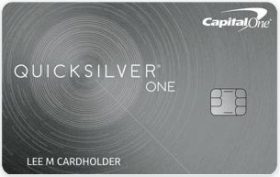 Pros
Pros
- No foreign transaction fees
- 1.5% cash back on all purchases
- Six months complimentary Uber One membership
Cons
- $39 annual fee
- Very high interest rate
The Capital One QuicksilverOne Cash Rewards Credit Card is best for anyone who’s already started making progress on their credit and has a score that falls somewhere in the fair range. In addition to earning cash rewards on all of your spending, this unsecured credit card offers automatic credit line reviews to help you borrow more as you prove you can handle it.
With this unsecured credit card, you’ll earn 1.5% cash back on every purchase you make and can redeem your rewards for cash, gift cards, and more. And after six months of having this card, you will be considered automatically for a higher credit line. If your account shows consistent on-time payments, you might be eligible.
The Capital One QuicksilverOne Cash Rewards Credit Card does not charge foreign transaction fees but does charge fees for cash advances and balance transfers. You’ll probably need a credit score of at least 600 to qualify.
This is the only card on our list that earns cash back rewards and it’s probably the best all around. But it requires a higher credit score than the others, so this is a better choice for people with older bankruptcies or this might be the card you get after one of the others we’ve mentioned. The Capital One QuicksilverOne Cash Rewards Credit Card also has a very high APR, so you definitely don’t want to run up a high credit card balance without paying it off.
Best for rebuilding credit: Capital One Platinum Secured Credit Card
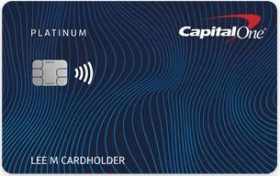 Pros
Pros
- No annual fee
- No foreign transaction fees
- Automatic credit limit reviews
- Can graduate to an unsecured card
Cons
- Security deposit required
- High interest rate
The Capital One Platinum Secured Credit Card is a flexible secured credit card that rewards responsible use and patience. It’s one of the best credit cards after bankruptcy because it does not charge an annual fee and gives you ways to upgrade your account over time.
With the Capital One Platinum Secured Credit Card, you’ll have your account automatically reviewed six months after opening to see if you qualify for a higher credit line, with a maximum credit limit of $1,000. To make repayments easier to budget around, you can choose your own monthly due date. To monitor your credit, you can use Capital One’s CreditWise tool to get alerts about TransUnion or Experian credit report changes.
Most secured credit cards offer you a credit limit equal to your security deposit. This card doesn’t quite follow that same rule. Based on your application, you will be asked to pay a $49, $99, or $200 refundable security deposit. That cash deposit gives you an initial credit limit of $200, no matter how much you put down. But if you make all of your payments on time, this secured card can graduate to an unsecured card and you can get your security deposit back.
The Capital One Platinum Secured Credit Card charges no hidden fees and provides more opportunities than the average card for unlocking better features as you work on your credit. If you’re looking to start with a secured card but would someday in the future prefer an unsecured card, this is one of your best options. Just be careful of that interest rate.
Secured vs. unsecured: Which is better?
The first decision you have to make when applying for a credit card after a recent bankruptcy is to choose either an unsecured or a secured credit card. This will significantly narrow down your options and give you the information you need to find the best credit card for you.
There are a number of both secured and unsecured credit cards out there for borrowers with poor credit and bankruptcies in their credit reports. These two types of credit cards offer different benefits and have different requirements.
Secured pros and cons
Secured cards are easy to get approved for but come with drawbacks like security deposit requirements and lower credit lines. Secured credit cards require a security deposit as collateral when you apply to show a credit card issuer that you’re serious about repaying your debt. Usually, the amount you deposit becomes your credit limit or close to it.
As long as you pay off your balance, you can often get your deposit back when you close your account. But if you’re unable to pay off your balance and you default on your card, the credit card issuer will keep your money. Lenders and credit card companies are more likely to consider applicants they wouldn’t otherwise, including those with bankruptcies in their file, for secured debt because they are taking less of a risk. If you can’t pay them back, they take your deposit.
Unsecured pros and cons
Unsecured credit cards are tougher to qualify for but tend to offer more benefits such as rewards, no or low annual fees, and higher credit limits. They do not require a security deposit, so they present more risk for lenders.
This means that unsecured cards have higher credit and income requirements to determine if you’re creditworthy. And although you can still get approved for some after a bankruptcy, you’ll have a harder time; and if approved, may be offered a less-than-ideal interest rate and credit limit.
Which one should you choose?
Both secured and unsecured cards report all of your payment activity to the three major credit bureaus. This means that at least for credit-building, these options are equal. If you make all of your payments on time each month, your credit will improve. If you miss payments or make them late, you’ll lose points in your credit score and damage your credit history.
If your credit score hasn’t recovered enough to qualify for an unsecured card and you can afford to put down at least a small deposit, you might want to choose a secured credit card. After enough time, you may be able to graduate to an unsecured card or get approved for a new one, if that’s what you want. If your credit has started to improve and you can pre-qualify for an unsecured credit card with a decent interest rate, this might be your best option.
How to choose a credit card when you’re rebuilding credit
Once you have a better idea of whether you want to go with a secured or unsecured option, here are the features to consider when choosing.
Annual fees
Almost any credit card you can get with bankruptcy in your file is going to charge an annual fee. You can think of this as a compromise between you and a credit card issuer. They’ll go easier on you and give you an account even with bad credit and you’ll pay them every year to keep it.
If you had excellent credit and could qualify for any card you want, an annual fee might not be worth paying. But when you’re rebuilding credit after bankruptcy and you need to borrow money to show you can repay debt, a credit card is important and annual fees are worth it in the long run.
Other fees
There are other fees besides an annual fee to be aware of when browsing credit cards. For example, some bad credit cards charge foreign transaction fees while others don’t. Almost all charge the following:
- Cash advance fees
- Balance transfer fees (balance transfers are usually only permitted with unsecured cards)
- Late fees
- Returned payment fees
Interest
Interest rates for credit cards you can qualify for with bad credit, including both unsecured and secured options, tend to have higher interest rates than cards that require fair, good, or excellent credit. This is another compromise you have to make, but you can still compare your options with different issuers to find the best offer you can pre-qualify for.
Expect a variable APR of at least 20% for a post-bankruptcy credit card. You can avoid paying interest by paying off your balance in full each month.
Credit limit
Your credit limit or credit line is the amount you’re allowed to borrow using your card each month. With a secured card, your credit limit is probably equal to or close to the amount you deposit. With an unsecured card, it’ll depend completely on your credit profile. Whatever it is, your limit will impact your credit utilization ratio or the amount of credit card debt you have over the total amount you’re allowed to borrow.
Credit cards that accept bankruptcies tend to have much lower credit limit minimums and maximums than other cards. You may be able to increase your limit but know that cards in this space tend to give you much less to borrow up front and over time.
However, this could be a good thing if you want to play things really safe and avoid living beyond your means.
Rewards
While credit card rewards are a nice perk, they shouldn’t be your main focus when rebuilding your credit after bankruptcy. You may not be able to find a card you can qualify for with bankruptcy in your history that pays cash back or other rewards, but you can set your sights on one of these someday.
Can you get approved for a credit card after bankruptcy?
Many credit cards, even those for poor credit, will not approve your application if you’ve filed for bankruptcy within the last two years. But a lot of them will.
Despite what you may have heard, it is possible to get a credit card after bankruptcy. That said, it’s often a good idea to wait until your bankruptcy is discharged before you apply for a credit card. Depending on the type of bankruptcy you filed, this could be just a few months or as long as five years. Chapter 7 bankruptcy, the most common type of bankruptcy, typically takes around six months.
Once your bankruptcy is discharged, you’ll have an easier time getting approved for credit because your debt will be dismissed. If your bankruptcy filing was very recent, consider a secured card. If it’s several months or a couple of years behind you, consider an unsecured one.
But while we’ve covered many credit cards that do approve applicants with bankruptcy on their credit, you’re not guaranteed to get one even if you’re pre-approved. Credit card companies can deny your credit card application if it doesn’t meet their criteria for approval. They’ll consider many factors when you apply including your employment, income, other debt, number of inquiries, payment history, and more. It’s up to the discretion of each credit card issuer to determine if you’re eligible for an account, bankruptcy or not.
To improve your chances of approval, continue working on your credit while you apply for cards because every little bit counts. Once approved, keep your credit utilization as low as possible to avoid taking on debt you can’t afford to repay. Think of your credit card like a debit card and only charge expenses you know you can pay back in full immediately.
Read more: How to use a credit card responsibly
Summary
Now that you know what the best credit cards after bankruptcy are, you have a decision to make. Any of these great credit cards can help you improve your credit and build your history back stronger than ever, but they all have different advantages and disadvantages that will make some choices perfect for one person and poor choices for someone else – and vice versa.
To get started, see what’s out there for you by submitting pre-qualification applications without affecting your credit. This will give you a good idea of what annual fees, interest rates, and credit limits you might be eligible for and which credit card is worth applying for now.

